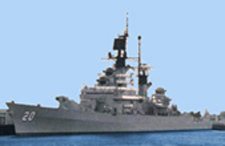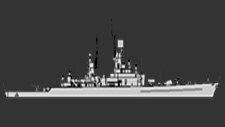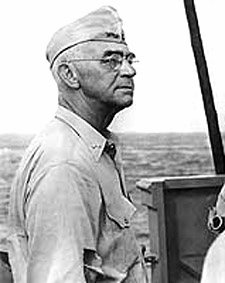 |
 |
|||||
|
RICHMOND K. TURNER (CG 20) |
The
keel of the USS RICHMOND K. TURNER was laid on January 9, 1961 by New
York Shipbuilding Corporation in Camden, New Jersey. One of nine Leahy-class
"double-ended" guided missile destroyers.
She departed Philadelphia Naval Shipyard August 10, 1964 for her homeport of San Diego, Calif., stopping briefly at Yorktown and Norfolk, Va., and then Guantanamo Bay, Cuba. She crossed through the Panama Canal, and after a port call in Acapulco, Mexico, arrived in San Diego on September 11, 1964. USS RICHMOND K. TURNER departed San Diego June 4, 1965 her first deployment to the Western Pacific. She joined Task Force 77 in the South China Sea area and served as missile support ship for the attack carriers CORAL SEA (CVA 43), INDEPENDENCE (CV 62), and ORISKANY (CV 34). She was reassigned to the Search and Rescue Destroyer Unit in the Tonkin Gulf in September 1965. After participating in missions in which eight aviators were rescued, she departed Subic Bay and arrived San Diego December 18. She stood out of San Diego October 15, 1966, bound a second time for Southeast Asian waters, returning to her homeport March 28, 1967 and making a midshipman training cruise to Pearl Harbor. She departed for her third tour off Vietnam June 10, 1968, and contributed to Fleet readiness in Asian waters until returning to San Diego in December 1968. RICHMOND K. TURNER assumed the duty as ASW Schoolship in the southern California operating areas. In February, she conducted a SecNav guest cruise, and March 1, she commenced an extensive updating of her shipboard missile systems at the Naval Station San Diego. She then underwent training and further preparations for her fourth WestPac deployment, which commenced in January 1970. She arrived in Yokosuka, Japan, March 4, 1970 and spent two months operating in the Sea of Japan. She operated off the coast of Vietnam from June until July 1970 and returned to San Diego in August after stopping at Guam and Pearl Harbor. On March 22, 1971, she embarked for Bath, Maine and arrived at the Bath Iron Works on April 27. She was decommissioned May 5, under a Navy wide program to enhance the anti-air warfare capability of major guided missile ships. TURNER was recommissioned at Bath Iron Works on May 17, 1972. For seven months, RICHMOND K. TURNER engaged in various trials, exercises, and refresher training along the east coast of the United States and in the Caribbean. She returned to Newport, R.I., November 22, 1972 and remained there until January 9, 1973, when she entered Boston Naval Shipyard for a two-month yard period. Leaving Boston in March, TURNER deployed on a UNITAS cruise to South America in 1973. RICHMOND K. TURNER was redesignated a CG-20 in July of 1975 and participated in Operation 200 which included the International Naval Review in New York City for the Nation's Bicentennial Celebration on July 4, 1976. In September 1978 the TURNER reported
to GTMO for REFTRAY. The day after arrival Turner was directed to intercept
and conduct surveillance of Soviet Naval units operating in the West
Indies. With that task completed Turner was then directed to transit
the Panama Canal and conduct surveillance operations off the contiguous
waters of western Nicaragua. The Turner received the Meritorious Unit
Commendation for these operations in March 1979. In July of 1979, While
operating with the 6th Fleet, Turner successfully launched a Harpoon
missile in the Gulf of Sidra, destroying the target at a range of 78
miles. This was the first firing of a Harpoon missile from a deployed
US Navy Ship. In May 1980 TURNER participated in Boston's OPSAIL 80 and was awarded a Meritorious Unit Citation for conducting two special operations. RICHMOND K. TURNER completed four highly successful Mediterranean deployments as part of the U.S. Sixth Fleet, prior to an extensive baseline overhaul at Charleston Naval Shipyard, Charleston, SC from January to December 1982. During this overhaul TURNER received numerous updates to modernize her combat systems suite. She was also fitted with the Vulcan Phalanx Close In Weapons System (CIWS) for self defense against cruise missiles. After this overhaul TURNER completed two more Mediterranean deployments, one of which included the successful launch of a Harpoon missile during a Gulf of Sidra operation. TURNER also completed a 1988 deployment to the Persian Gulf and was a participant of Operation Earnest Will. Upon her return to the United States, TURNER was overhauled in Ingalls Shipyard at Pascagoula, Mississippi,where she received the New Threat Upgrade (NTU) to her Combat Direction System as well as many engineering improvements. In response to the crisis in the Persian Gulf caused by Iraq's invasion of Kuwait, RICHMOND K. TURNER deployed early as a primary AAW unit in the THEODORE ROOSEVELT (CVN 71) battle group, which arrived in the theater just before hostilities broke out. During 60 days in the Persian Gulf, TURNER provided protection to four carriers and served as an advance picket ship in the mine infested waters off Kuwait. Following the cease fire, TURNER relocated to the Red Sea where she participated in the continuing maritime interception operations in support of U.N. sanctions against Iraq. Escorting USS THEODORE ROOSEVELT through
the Suez Canal in late April 1991, TURNER participated in Operation
Provide Comfort, a massive relief effort to help tens of thousands of
Kurdish refugees who fled the turmoil of Iraq following that country's
defeat in the war. During this time RICHMOND K. TURNER became the Anti-Air
Warfare Commander for the Aircraft Carrier Striking Force, U.S. Sixth
Fleet. She made a final deployment to the Mediterranean as a part of the USS THEODORE ROOSEVELT battle group and served as an anti-air warfare command during Operation Deny Flight over the Former Republic of Yugoslavia and Bosnia. Prior to her decommissioning on March 31, 1995, TURNER served as the test platform for the Navy's Light-weight Exoatmosheric Projectile (LEAP) Program, firing the first LEAP shot ever and launching the Navy into the future of missile technology. On August 9, 1998, USS RICHMOND K. TURNER was sunk as a target near Puerto Rico. The SINKEX was conducted by the USS ENTERPRISE battle group including the USS PHILIPPINE SEA (CG 58), USS THORN (DD 988), USS NICHOLSON (DD 982) and Carrier Air Wing 3.
|
|||||
 |
||||||
|
Displacement: 8,200 tons (full load)
|
||||||
 |
||||||
|
Admiral Turner made the cover of Time Magazine in February 1944 and his actions at Guadalcanal were described in a comic strip called "Commander of the Crocodile Fleet" for True Comics which was published in issue 37, July 1944. He retained this command under Halsey
and advanced his forces through 1943 to Rendova Island. After loosing
his flagship there, he turned command over to Theodore Stark Wilkinson
and left for Pearl Harbor, there receiving command over yet another
amphibious force, this time the entire forces of Spruance's Fifth Fleet.
During operations against Okinawa, Turner's units beached the US ground troops without problems and Turner initiated destroyer picket operations to help repel Kamikazes. On May 17th 1945, Admiral Nimitz relieved
Turner with Rear-Admiral Harry Hill, ordering him to plan for the projected
landing on Kyushu, Japan, when the atomic bombs brought an end to the
struggle. He is buried in Golden Gate National
Cemetery in San Bruno, California. For more information about Admiral Richmond
K. Turner, read the online version of George C. Dyer's story The
Amphibians Came To Conquer. |
||||||
![[ Home Page ]](Home_Page.jpg)